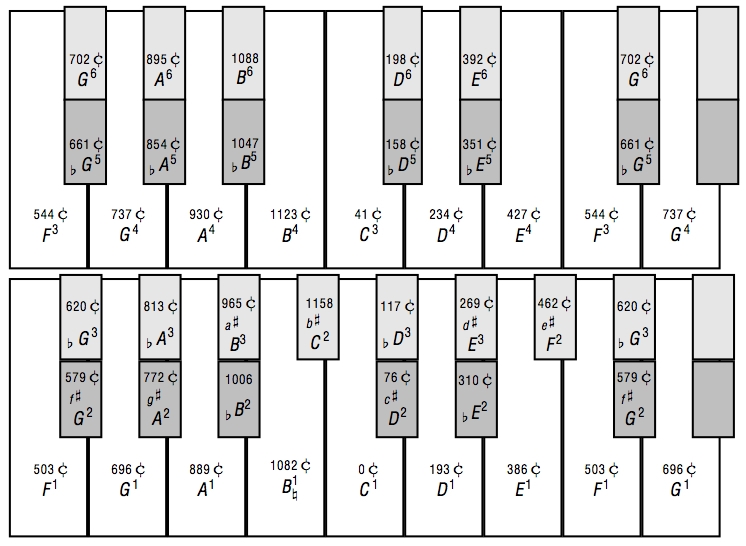More Tuning and Experimental Music
Microtonal Keyboards from the Italian Renaissance. . . and La Monte Young
Contents
Introduction
In "Number and Numeral", Kittler describes the shift from the interval ratios of the ancient Greeks to modern equal temperament as a historical necessity, precipitated by mathematics. He writes that in 1595:
Simon Steven proceeded to bid farewell to Greek music. . . . Steven recognized decimal fractions to be a feasible way of basing all keys on a single, albeit irrational ratio. Intervals whose essence or purity resided in their difference were replaced by the twelfth root of two, as a tempered semitone. There was no other way in which Greek fifths and late mediaeval thirds could be turned into fugues. . . . Centuries had to pass until all musicians, composers and instrument builders bowed to Stevin's numerals, but in the end they all did. It is only since then that enharmonic confusions–that is, modulations through all 24 keys–have been possible; and only since then can we listen to the sounds of symphonies, sonatas, soulful thirds and seventh chords. A mere sign, 2^1/12, has equipped us with historically unheard-of ears.
A convenient story. And indeed, most keyboards today have twelve keys per octave; each half step is more-or-less the same size; and the instructors of musicianship classes can teach the chromatic scale as one particular musical structure [musical example]. But there's a difference between most musicians and all musicians, as well as between convenience and necessity.
Kittler's historical formula here is a bit too compact for his own good. Knowingly or not, he's throwing his lot in with the musical establishment: the conservatory deans, Mozart enthusiasts, and Sibelius marketers who would like you to believe that there are twelve notes per octave: no more, no less. The question for today is: who's crazier, the lunatics who, in defiance of musical norms and common sense, devote their lives to microtonality—studying ancient Greek music theory, designing weird instruments (and learning to play them!), studying tuning differences that are so minute as to be unintelligible without technological assistance. . .who's crazier, the tuning nuts of the world, or the majority who believe that tuning is simply a matter of convenience? Did we become musicians to take boring shortcuts?
A paranoid musician might view Kittler's history of tuning progress as a conspiracy designed to make experimental music and musicians disappear. Fortunately, once you see Harry Partch playing the Spoils of War in a magenta kimono, the weight of musical tradition becomes a bit less oppressive. I have written this lecture to lighten the burden even more: first, with a brief tour of Renaissance microtonal music, and second, with an longish introduction to the work of La Monte Young.
Renaissance Microtonal Music
You don't need twelve keys per octave to write a fugue. In 1618, a Neapolitan botanist named Fabio Colonna proved this with some musical examples from his treatise La Sambuca Lincea, which I've synthesized for you.
- First, a fugue exposition using what Colonna calls the "soft enharmonic"
- Second, fugue exposition using the "intense enharmonic"
Colonna's tuning uses 31 tones per octave, and you can hear intervals in each fugue theme that are smaller than a half step. This music was not merely speculative: Colonna himself had a microtonal keyboard with six rows and 31 keys per octave, which looked something like this:
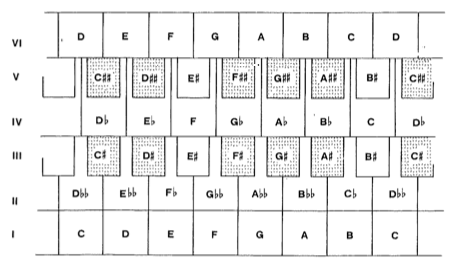
Colonna's keyboard: La Sambuca Lincea, xlvi.
Without getting into the gritty details of the tuning scheme, I will simply point out that it differentiates between enharmonic equivalences we take for granted on a 12-key-per-octave keyboard. For example, whereas C-double-sharp, D, and E-double-flat are all the same key according to the normals, in Colonna's strange musical universe they are distinct (see the keyboard layout above to convince yourself of this). In Colonna's musical universe, there are not 24 major and minor keys, but rather 62. His circle of fifths is enormous.
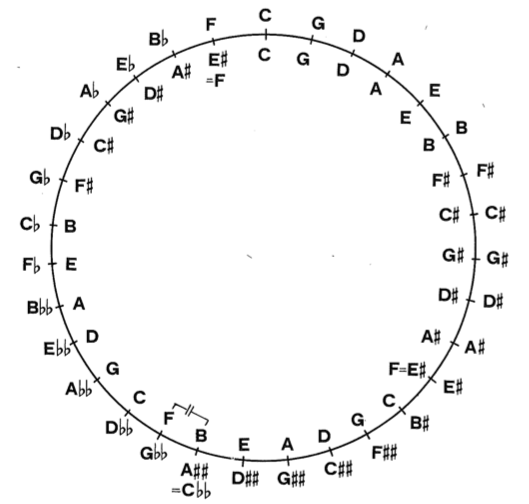
Colonna's circle of fifths. The outer ring is the 31-tone cycle; the inner ring is its 12-tone approximation. Ibid., xxxix.
A few points. First: it is hardly obvious that twelve is the "right" number of keys per octave. Keyboard design was not a matter of divine mathematical illumination, but rather of experimentation and evolution. The earliest medieval keyboards, reflecting the chant literature, had included only the white keys and a B-flat. By the end of the fourteenth century, keyboard builders had filled in the "missing" black notes, in the layout familiar to us today (Keislar, "History and Principles of Microtonal Keyboards", 2). Why should twelve be the stopping point? This brings me to the second point: by the late-sixteenth century, Colonna was hardly the only musician experimenting with extended tuning systems and keyboard designs. Here's a design for an 18-key-per-octave keyboard, from the French polymath Marin Mersenne:
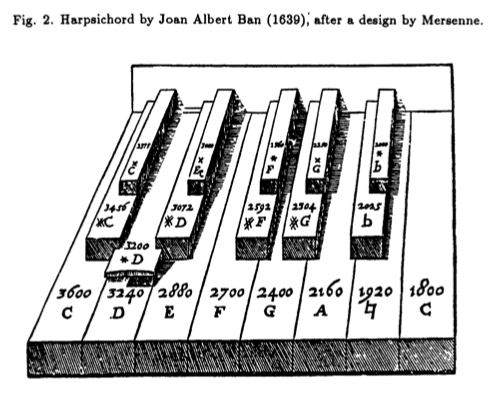
Keislar, "History and Principles of Microtonal Keyboard Design", 2 bis.
Here's a beautiful, orderly design for another 31-key-per-octave organ, from Italy:
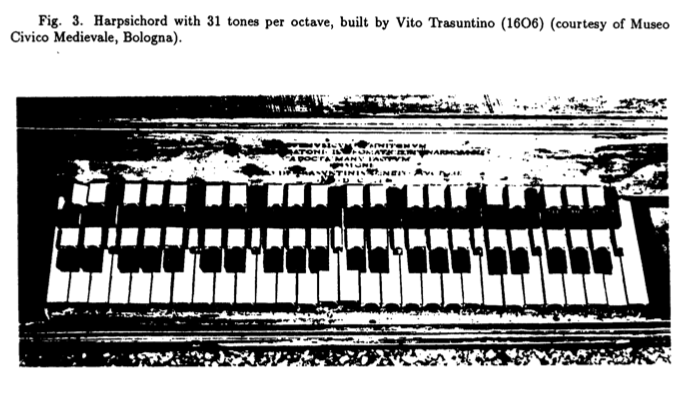
Ibid., 3 bis.
Here's a design for an orderly 19-key-per-octave keyboard, from the renowned Venetian theorist Zarlino. This one's a bit earlier, from 1558:
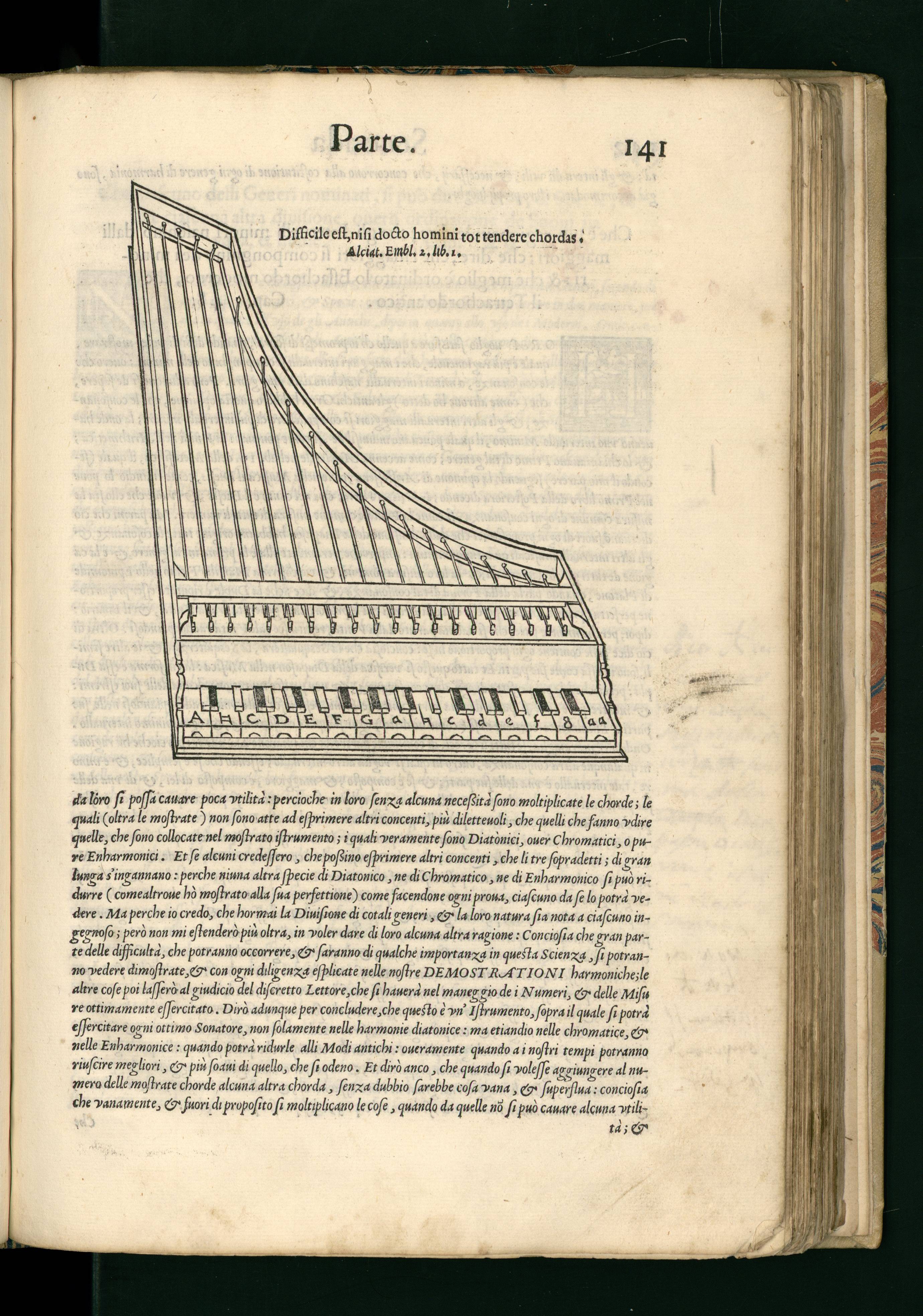
From the Istitutioni harmoniche, part 2, 141.
Finally, the 36-key-per-octave layout of Nicola Vicentino's Archicembalo:
These were real instruments; musicians learned how to play them and, in some cases, wrote pieces for them. [Recording of Vicentino's enharmonic madrigals: 57084] So why this explosion of experimental keyboard design in the Renaissance, especially in Italy? My third point: this was not simply a matter of historical necessity. It is better understood as the volatile collision of three musical factors:
A growing interest in musical chromaticism and enharmonicism.
Play Gesualdo's Moro, lasso. Scrolling score. Text:
I die, alas, in my suffering,And she who could give me life,Alas, kills me and will not help me.O sorrowful fate,She who could give me life,Alas, gives me death.Encourage everyone to watch Werner Herzog's Death in Five Voices
A renewed interest in ancient Greek music theory, both to through modern musical practice into relief and to expand its expressive power. Vincenzo Galilei, a lutenist, composer, and father of the illustrious Galileo, wrote a Dialogue on Ancient and Modern Music in 1581, in which he outlines the tuning theory of the ancients and, by devising musical experiments, tests how they apply to modern practice. An excerpt from the Dialogue:
The ancients numbered music among the arts that they called liberal, that is, worthy of a free person. The Greeks, masters and inventors of music—along with all the other sciences—rightfully held it in great esteem. Since it is a delight of life and also useful to virtue, the best legislators ordered that it should be taught to those who were born to attain perfection and human blessedness, which is the goal of a city. But in the course of time, the Greeks lost music and also the other disciplines along with their empire. . . .
Meanwhile, Italy for a long time suffered great floods of barbarians. Every spark of science was extinguished, and as if everyone were overwhelmed by a heavy lethargy of ignorance, people lived without any desire for knowledge. They had about as much understand of music as of the West Indies, and they persisted in this blindness until first Gaffurio, then Glarean, and finally Zarlino—truly princes in this modern practice—began to investigate what it had been and sought to rescue it from the darkness in which it was buried. Little by little, the restored the part that they understood and appreciated to the state in which we now find it. But some intellectuals do not believe that it has attained its ancient heights, as we may gather from countless places in the ancient histories and from their poets and philosophers. Nor do they believe that we have reached the true and perfect knowledge of music, which may be owed to the coarseness of the times, the difficulty of the subject, and the scarcity of good interpreters. . . . (Vincenzo Galilei, trans. Claude V. Palisca, Dialogue on Ancient and Modern Music, 6.)
Finally, and relatedly:
The birth of modern experimental science and acoustics, which is inseparable from (2). [Galileo's acoustic experiments: pendulums and water glasses]
In 16th century Italy, we find the peculiar mix of enharmonicism, Greek music theory and acoustics that will animate the work of American experimentalists four centuries later. We have already seen these forces at play in the work of Harry Partch; let's turn now to La Monte Young.
La Monte Young
Highlight the intersection of two experimental traditions:
The just-intonation tradition (Partch et al.)
Fluxus (via Cage)
read excerpts from the "Fluxus Anthology" liner notes
What is Fluxus? (George Brecht)
In Fluxus there has never been any attempt to agree on aims or methods; individuals with something unnameable in common have simply naturally coalesced to publish and perform their work. Perhaps this common something is a feeling that the bounds of art are much wider than they have conventionally seemed, or that art and certain long-established bounds are no longer very useful. At any rate, individuals in Europe, the U.S.A., and Japan have discovered each other's work and found it nourishing (or something) and have grown objects and events which are original, and often uncategorizable, in a strange new way.
Whether you think that concert halls, theaters, and art galleries are the natural place to present music, performance, and objects, or find these places mummifying, preferring streets, homes, and railway stations, or do not find it useful to distinguish between these two aspects of the world theater, there is someone associated with Fluxus who agrees with you. Artists, anti-artists, non-artists, anartists, the politically committed and the apolitical, poets of non-poetry, non-dancers dancing, doers, undoers, and non-doers, Fluxus encompasses opposites. Consider opposing it, supporting it, ignoring it, changing your mind.
Manifesto (George Maciunas)
To justify the traditional artist's "professional, parasitic and elite status in society", he wrote, "art must appear to be complex, pretentious, profound, serious, intellectual, inspired, skillful, significant and theatrical; it must appear to be valuable as a commodity so as to provide the artist an income." Flux art-amusement, on the other hand, must be "simple, amusing, unpretentious, concerned with insignificances, require no skill or countless rehearsals, have no commodity or institutional value. . . Fluxus art'amusement is the rear-guard. . . it strives for the monostructual and non-theatrical qualities of simple natural events, a game or a gag. It is the fusion of Spike Jones, vaudeville, gag, children's games and Duchamp. . . obtainable by all and eventually produced by all."
Cage influence (Dick Higgins)
One part of the origin of Fluxus was the classes in "Experimental Composition" which John Cage taught at the New School for Social Research in New York City in the late 1950's. George Brecht, Jackson Mac Low, Al Hansen, myself and various others took classes there, and we were expected to bring in a new composition of some kind for more or less every class. The only instruments in the classroom were a grand piano, a collection of oriental instruments used for Henry Cowell's class in "Music of the World's Peoples" (which met in the same classroom), and, as they accumulated, a large number of toys which we bought over a period of time to try our piece out. Other that that, there was only whatever we happened to have in our pockets—combs, coins, and such-like. In a situation like that, one couldn't very well write for string quartets or small orchestras. Thus, from the beginning, that class was oriented towards unconventional means of making art out of sounds. One aspect of Cage's attitde was shown by one of him first questions: "Is there anyone here who has never before composed any music?" Several hands went up. "Is there anyone of you who cannot read music?" Al Hansen's hand went up. "Good", said Cage to Hansen. "You at least have nothing to un-learn."
The deatils of Cage's class are pretty well known, from Richard Kostelanetz's John Cage, available in Germany and the USA. I won't repeat that story. Basically, he emphasized the notation, the process of realizing the notation, the implications of the entire process, and he de-emphasized most craftmanly elements of composition. It was largely stripped down to aesthetics.
After the series of classes got under way, many of us students found that the little pieces we were making for his classes were not just classroom exercises to us, but were fully satisfying. So we made a good relationship with some places in the neighborhood, such as the "E-pit-o-me Coffee Shop", and we tried out our pieces on the public there, often performing under the name of the New York Audiovisual Group.
Cage himself never made any pieces which resembled Fluxus pieces. For him our compositions were, I think, not very satisfying. Nor did we necessarily accept all his teaching,s, for example his mistrust of expression or of mimesis of all kinds. His role was more like an uncle and godfather to us than of a father.
27-part (!) interview on NewMusicBox. Watch a couple videos of him speaking:
In class performance of Composition 1960 No. 7 (10-15 min.)
- Discussion: what did you hear? What's the character of the fifth?
The Well-Tuned Piano (DVD 749). Watch the opening
